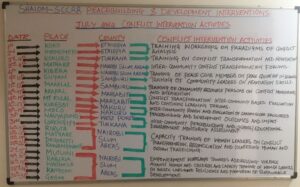(Shalom-SCCRR Department of Research
Director: Prof. W. K. Omoka.
The voice of Peace Practitioners and Researchers)
MULTI-STAKEHOLDER APPROACH IN THE MANAGEMENT OF NATURAL RESOURCE-BASED INTER-COMMUNAL CONFLICT ALONG TURKANA-WEST POKOT BORDERLINE: THE MISSING LINK.
{© 2020 Shalom-SCCRR}*
By Esther Njeri Kibe, MA.
(Peer-reviewed by Prof. W. K. Omoka, Rev. Dr. Patrick Devine, and Shalom-SCCRR Dept. of Research)
Introduction
It is widely acknowledged that peacebuilding is a challenge that can only be addressed through the combined effort of different groups, agencies and sectors, with a multitude of strategies at different levels. Bringing together the resources, knowledge, expertise, perspectives and constituencies of the various stakeholders can lead to the political will, collective capacities and sense of ownership needed to build sustainable peace in communities (Aulin, 2015). The benefit of multi-stakeholder approach is that it brings synergy in conflict intervention where different participating stakeholders and their initiatives are complementary to each other. From this background, this paper, therefore, explores the local-based multi-stakeholder approach in the management of natural resource-based conflict along the Turkana-West Pokot borderline. This paper has six parts: the contextual background of the conflict; parties and their roles in the conflict; causes of this conflict and their dynamics; intervention strategies being implemented by SCCRR to address the natural resource-based conflict; and, conclusion.
The data used in this paper was sourced from Shalom-SCCRR’s Turkana-Pokot conflict analysis (2017), field monitoring reports (conflict incidence and project monitoring), conflict situational analysis reports, workshop reports and other relevant literature to the topic of discussion.
Contextual background of the conflict
Turkana and West Pokot Counties share one of the longest borderline in Kenya. Like most of the other parts of northern Kenya, this borderline mainly suffers from the problems of inter-communal conflicts between the pastoralist communities. The borderline is predominantly inhabited by the pastoralist from both the Turkana and Pokot communities who have been locked in a protracted inter-ethnic conflict over the years. The conflict has continued to persist to date despite interventions from different actors including the government, non-governmental organizations and faith based institutions (Devine, 2016). The conflict prone areas (hot spots) along the borderline of the two counties are majorly Loima Sub-County, Turkana South Sub-County, Pokot Central Sub-County and Pokot North Sub-County (Noonan, O & Kevlihan, R., 2018; Shalom-SCCRR, 2017).
The protracted conflict between the Turkana and Pokot communities along the borderline has resulted to loss of many lives, massive loss of livestock, displacement of people, affected inter-communal relations, disruption to socio-economic activities and livelihood systems, destruction and closure of education facilities, stalled development among many other negative effects. Most agro-pastoral communities are most of the time hindered from accessing large areas of pasture, water and fertile agricultural lands due to this conflict.
Parties and their different role in Turkana – Pokot conflict
There are a multitude of parties or stakeholders playing different roles in the Turkana-Pokot conflict along the borderline. When the 593 respondents were asked to identify the roles played by different stakeholders in inter-communal conflict between the two communities, the responses were distributed as shown in Table 1 below (Shalom-SCCRR, 2017).
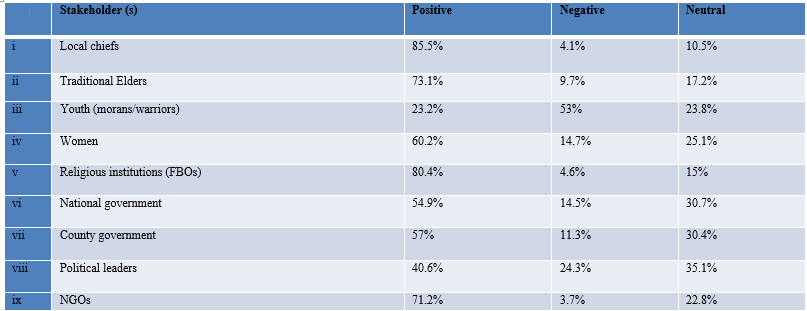
From Table 1 above, 53% of the respondents categorized the youth (morans/warriors) as playing a negative role in the conflict. This, therefore, means that the youth (morans/warriors) are categorized as the primary stakeholders (perpetrators) since they are the ones actively involved or in the forefront of the conflict (executers). Only 24.3% of the respondents categorized political leaders as spoilers in regards to their contribution to conflict between the two communities. The main reason given for this was that some political leaders from both sides occasionally incite their respective communities through their utterances sometimes triggering mostly land/territorial-based conflict between their communities.
The majority of the respondents categorized local chiefs (85.5%), religious institutions (80.4%), traditional elders (73.1%), NGOs (71.2%) and women (60.2%) as peace agents. It is important to note that there has been some significant changes in the role played particularly by the traditional elders and women. Previously, the two categories of stakeholders used to play a negative role (labelled as spoilers) where the elders used to bless the youth (morans/warriors) through offering sacrifices before they go to execute raids. Women on the other hand used to encourage the youth (morans/warriors) by praising them through singing to them heroic songs when going and coming back from the raids, and singing very demeaning and cowardice songs to their sons who refuse to go for raids.
Causes of the conflict and their dynamics
The causes of inter-communal conflict along the Turkana-West Pokot borderline is as a result of intertwined and intricate factors including issues related to governance policies, socio-economic and political marginalization, availability of illegal arms, competition over natural resources, inadequate land tenure system, insecurity, inadequate utilization of traditional mechanisms for addressing conflict among many other factors (Devine, 2016; Kermut, 2016). Devine (2016) particularly prioritized and ranked core resources (water, pasture, and livestock), political economy (manifested through land/territorial dispute), and infrastructure-insecurity (infrastructure deficiency and ineffectiveness) as the underlying causes of conflict between the Turkana and Pokot communities. Based on the SCCRR’s conflict analysis conducted along the Turkana-West Pokot borderline, competition over natural resources (pasture, water, and territorial/boundary dispute) was found to be the top-ranked cause of conflict between the two communities (Shalom-SCCRR, 2017).
Chart 1: Ranking of the factors that frequently causes inter-communal conflict along the Turkana-West Pokot borderline (Shalom-SCCRR’s Turkana – West Pokot conflict analysis, 2017).
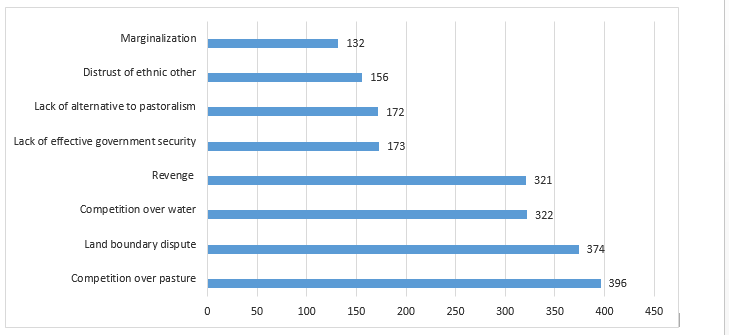
In Chart 1 above, an average of 364 out of 593 (61.4%) respondents that participated in the research prioritized competition over natural resources – pasture (396), land boundary dispute (374) and water (322) – as the highly ranked factor that frequently causes inter-communal conflict along the Turkana – West Pokot borderline. 66.8% of the participants ranked competition over pasture as the first prioritised natural resource that causes conflict between the two communities. The main reason given for this was that during drought seasons, scarcity of pasture for livestock is experienced hence increased in the competition over the available pasture sometimes even through forceful means. 63.1% of the respondents ranked land boundary dispute as the second in the prioritised list owing to some valuable natural resources (minerals and oil deposits) that are found underneath the land in these areas. Moreover, some portion of the land along this borderline is fertile hence good for farming and grazing of livestock leading to the dispute over the use and ownership of the land. Furthermore, some significant respondents argued that all other natural resources including minerals, oil, pasture and water are all found in the land; hence the conflict over the ownership of the land in order to benefit from all the resources found in it.
Natural resource-based inter-communal conflict between the two communities can be categorized into three main intertwined dimensions, namely the structural, proximate and trigger. Structurally, there exist inappropriate government laws and policies pertaining to the management of natural resources among the pastoralist communities. The government through various policies and laws has not adequately considered pastoralists’ interests in regards to the usage and access to pasture and water for their livestock. Most of these policies and laws are geared towards extraction, exploitation and permits of other extractive resources mostly in other parts of the country. Moreover, there is lack of appropriate and effective land tenure policies and laws in pastoral areas creating a gap in terms of respecting and protecting pastoralists’ land rights.
At the proximate dimension, traditional system for sharing pasture and water between the pastoralist communities have been weakened and undermined by the government. Government’s officials have at times overruled customary institutions and authority of elders and have made unilateral decisions in pastoralist affairs rather jointly working with elders or in line with elders’ decisions. Moreover, traditional elders have been co-opted by the political leaders for their own political interests. As a result, the elders are, therefore, unable to enforce agreements in regards to the sharing of grazing fields and water points along the borderline.
The trigger factors of this conflict mainly include drought and political incitement. Natural resource-based conflict increases during the drought seasons when there is scarcity of pasture and water for livestock. Frequent spells of drought forces the pastoralist communities to migrate in search pasture and water for their livestock. This in turn results to increased ‘climate migration’ inter-communal conflicts between these communities. Furthermore, negative utterances by political leaders from both communities particularly in regards to the issue of land/territorial boundary sometimes trigger natural resource-based conflicts between the members of the pastoralist communities along the borderline.
Application of Multi-Stakeholder Approach in the management of natural resource-based inter-communal conflict along the Turkana–West Pokot borderline.
Although different stakeholders are involved in conflict intervention along the Turkana-West Pokot borderline, there are some gaps in terms of effective collaboration and coordination among stakeholders particularly in the management of natural resource-based inter-communal conflict.
Table 2: To what extent are the following stakeholders involved in the management of natural resource-based inter-communal conflict along the Turkana-West Pokot borderline?
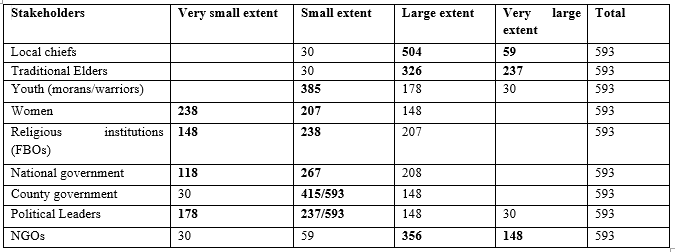
From Table 2 above, the extent to which stakeholders are involved in the management of natural resource-based inter-communal conflict along the Turkana-West Pokot borderline vary significantly. The respondents identified local chiefs (563), traditional elders (563) and NGOs (504) to be the main stakeholders that are mostly involved in the management of natural resource-based inter-communal conflict along this borderline. According to the respondents, there is minimal involvement of women (445), political leaders (415), the morans/warriors (385), religious institutions (386) and government (both national & counties) (415) in the management of natural resource-based inter-communal conflict in this borderline.
Chart 2: Do different stakeholders collaborate in the management of natural resource-based inter-communal conflict along the Turkana-West Pokot borderline?
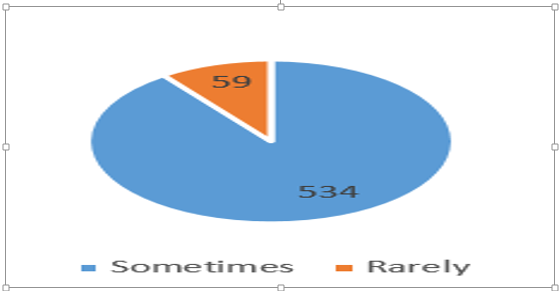
As shown in Chart 2 above, while 534 people responded that different stakeholders sometimes collaborate in the management of natural resource-based inter-communal conflicts in the borderline, the rest of them (59) even asserted that the stakeholders rarely collaborate. It is, therefore, clear that there is minimal collaboration among different stakeholders in the management of natural resource-based inter-communal conflicts along the Turkana-West Pokot borderline.
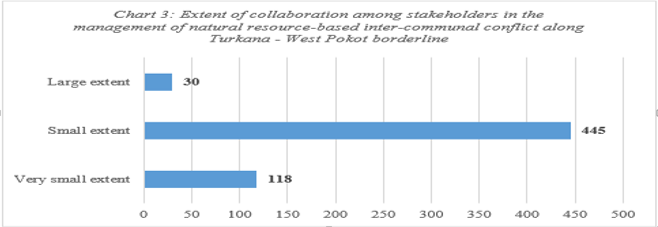
As shown in Chart 3, 445, and 118 respondents rated the collaboration among stakeholders in the management of natural resource-based inter-communal conflict to a small and very small extent respectively. According to the respondents, the stakeholders that sometimes collaborate in this borderline are mainly the local chiefs, traditional elders, and NGOs. The three categories of stakeholders collaborate in spearheading the sharing of pasture and water for livestock, and in facilitating minimal inter-communal dialogues for addressing conflicts related to natural resources.
From this data, it can, therefore, be concluded that there is ineffective collaboration among different stakeholders in the management of natural resource-based inter-communal conflict along the Turkana – West Pokot borderline. However, there are a number of factors that affect effective collaboration among these stakeholders and the respondents prioritised only three main factors as discussed herein:
Lack of a framework for collaboration: There is lack of an elaborate and organized framework for multi-stakeholder collaboration in the management of conflicts related to natural resources in this borderline. According to the respondents, there is not any organised framework that brings different stakeholders together in addressing natural resource-based conflicts. As a result different stakeholders along the Turkana-West Pokot borderline work in a disjoint manner.
Ineffective collaboration between Turkana and West Pokot county governments: There is minimal collaboration between the two county governments. There is disinclination from the leadership of the two counties particularly in the management of natural resource-based conflicts between the pastoralist communities. According to the respondents, instead of developing or enhancing local-based arrangements by which the two pastoralist communities can jointly share and utilise contested grazing fields and water points, some local politicians occasionally incite their respective communities on the basis of the disputed inter-county boundary.
Financial challenges: The participants noted that although some stakeholders may be willing to collaborate in spearheading the management of natural resource-based conflicts in this borderline, they most of the time experience challenges with funds to be able to facilitate their movement, initiatives and operations.
SCCRR’s Intervention Strategies
As presented in this paper, there is a missing link in regards to the coordination and collaboration among different stakeholders in the management of natural resource-based inter-communal conflict along the Turkana-West Pokot borderline. To try and bridge this gap, Shalom-SCCRR is implementing a Multi-Stakeholder Approach in the management of natural resource-based inter-communal conflict in this borderline as shown in Figure 1 below.

Through this strategy, Shalom-SCCRR is strengthening local-based structures for effective community mobilization, coordination, and collaboration in the management of natural resource-based conflict along the borderline. The categories of stakeholders and institutions in Figure 1 above were mapped, mobilized, and constituted to work within this framework based on their roles and the gaps found in their involvement in the management of natural resource-based inter-communal conflicts along the Turkana-West Pokot borderline as discussed in sections on the ‘parties and their role in Turkana-Pokot conflict’ (page 2) and ‘Application of Multi-Stakeholder Approach in the management of natural resource-based inter-communal conflict along Turkana – West Pokot borderline (pages 4 – 6).’
At the center of this structure are the Natural Resource Management (NRM) Committees that were established by Shalom-SCCRR and are being empowered with the capacities to significantly contribute to the management of natural resource-based conflicts in the borderline. The stakeholders in these committees constitute of key influential grassroots’ leaders in the form of the local chiefs, village elders, women leaders, youth leaders, religious leaders and National Police Reservists (NPRs).
In this framework, the general role of the NRM committees is to coordinate other stakeholders in the management of conflicts related to natural resources. The Committees have already drafted NRM proposals that will inform the development of the joint inter-communal NRM Agreements that will be utilised between the Turkana and Pokot pastoralist communities along the borderline. Although the development of the joint inter-communal NRM Agreements will be spearheaded by the Committees, representatives from the Turkana and West Pokot county governments (Peace Directorates & MCAs), local-based NGOs (APaD & SIKOM), Middle-Level Stakeholders (chiefs’ forums [local chiefs], District Peace Committees [Peace Coordinators], Security Agents [Police/ASTU] & county wards [ward administrators]) and local-based community groups [traditional elders’ forums, women groups, youth groups [warriors/morans], religious groups and NPRs]) will all be involved in the whole process from development to the implementation stages.
Through the implementation of this strategy so far, there has been a significant reduction of conflicts related to competition over grazing fields and water points between the Turkana and Pokot pastoralist communities along the borderline. The frequency of these conflicts has decreased from an average of two cases a month to one case in four months (SCCRR’s conflict incidence reports, 2019 – 2020). The members of the NRM Committees and the Middle Level Stakeholders have been in the forefront in organizing and facilitating local-based inter-communal dialogues that have resulted to the reported cases of sharing of pasture and water for livestock between the pastoralist communities along the Turkana-West Pokot borderline (SCCRR’s project monitoring reports, 2019 – 2020). This has further contributed to the reduction of inter-communal killings that were rampant when there were many incidences of conflict over grazing fields and water points.
Conclusion
The Multi-Stakeholder Approach has been the missing link in the management of natural resource-based inter-communal conflicts along the Turkana-West Pokot borderline. There was not any existing organized framework that brought together different relevant stakeholders with the grand aim of collaborating in the management of natural resource related inter-communal conflicts. However, the Shalom-SCCRR has established a Multi-Stakeholder framework where different stakeholders from the grassroots, middle and top levels of leadership are working together in the management of natural resource-based in the context of Turkana – Pokot conflict along their borderline.
The implementation of this approach along the Turkana-West Pokot borderline has contributed to the improved collaboration among different stakeholders in the management of natural resource-based conflict between the two communities. As a result, there has been a significant decrease in the number of conflict incidences related to natural resources reported on a monthly basis. Instead, there has been some improvement in the level of co-operation between the members of the pastoralist communities particularly in the sharing of grazing fields, water points and mining of minerals (particularly gold). Some more markets have been opened and the members from the two communities are currently engaged in inter-communal business transaction in the form of livestock trading and farm produce (maize and beans). These are very significant ‘baby-steps’ towards peaceful co-existence between the pastoralist communities in this borderline.
* This document is copyright to Shalom-SCCRR and cannot be reproduced without permission. Quotations from it should be acknowledged to Shalom-SCCRR
References
Aulin, J., (2015). Multi-Stakeholder Process for Conflict Prevention and Peacebuilding: A Manual. Netherlands, Hague: Global Partnership for the Prevention of Armed Conflict.
Devine, P., (2016). Persistent Conflict between the Pokot and the Turkana: Causes and Policy Implications [Unpublished Ph.D. Thesis]. University of Nairobi, Kenya. http://erepository.uonbi.ac.ke/handle/11295/97476
Kermut, M.S., (2016). The Silent War: Pokot and Turkana [Unpublished M.A. Thesis]. University of Oregon, United States.
Noonan, O & Kevlihan, R. (2018). Managing conflict in north-west Kenya: the siege of Loregon and its aftermath, Conflict, Security & Development, 18:2, 137-157, DOI: 10.1080/14678802.2018.1447862
Shalom-SCCRR (2017). Dynamics of Turkana – Pokot Conflict: An Empirical Exploration [Unpublished manuscript]. SCCRR-Nairobi, Kenya.
Schilling, J., Opiyo, F.O. & Scheffran, J. (2012). Raiding pastoralism livelihoods: motives and effects of violent conflict in north-western Kenya. Pastoralism, Research, Policy, and Practice 2 (1).

By Esther Njeri Kibe, MA,
Program Officer (Marsabit & Turkana-West Pokot Projects)
Shalom Center for Conflict Resolution and Reconciliation

